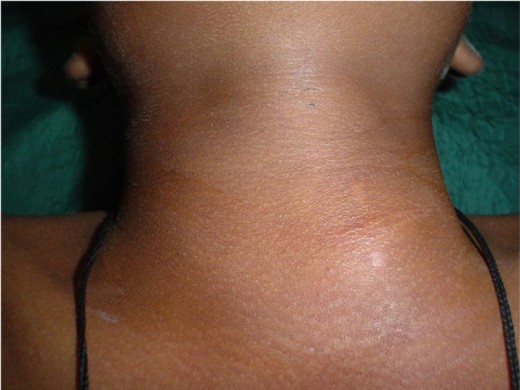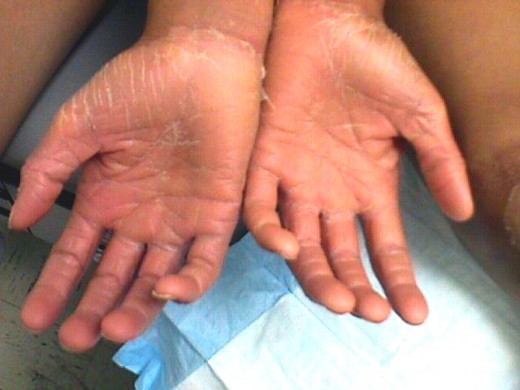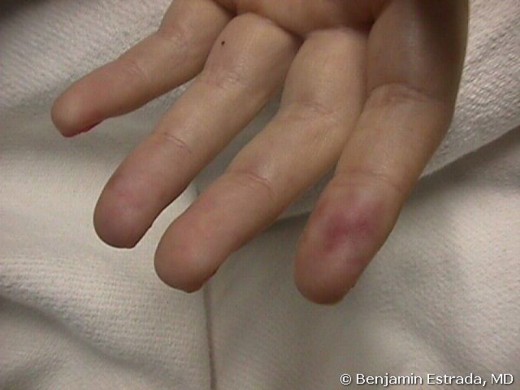Streptococcal Infections: Health Significance As Bacterial Cocci Causing Systemic Diseases
The Neck, Showing Slight Lymphadenitis As A Streptococcal Infection

Streptococcal Infections
Streptococci are among the commonest bacterial pathogens of man. They produce several pathological lesions. They are Gram- positive cocci, spherical or oval in shape, 0.5 to 1u in diameter and are arranged in chains. Streptococcus pyogenes produces several toxins and enzymes.
Pathogenesis And Pathology: Streptococcal infections cause the following pyogenic lesions:
- Tonsillitis
- Pharyngitis
- Scarlet fever
- Local extension from tonsillitis giving rise to complications like peritonsillar absecesses, sinusitis, otitis media, mastoiditis, and meningitis.
- Female genital tract infections- puerperal sepsis, pelvic cellulitis, peritonitis and septicemia
- Skin infections- erysipelas, impetigo, infection of wounds and burns
- Lymphadenitis
- Abscesses in different parts of the body
- Acute rheumatic fever
- Acute glomerulonephritis
Comparison Of Rheumatic Fever And Glomerulonephritis
Acute Rheumatic Fever
| Acute Glomerulonephritis
| |
|---|---|---|
Site of Infection
| Throat
| Throat or skin
|
Prior sensitisation
| Essential
| Not necessary
|
Serotypes of Streptococcus pyogenes
| Any
| Nephritogenic types only (12, 44, 2, 52, 55, 57, 4)
|
Immune response
| Marked
| Moderate
|
Complement level
| Unaffected
| Lowered
|
Streptococcus viridians: This produces subacute bacterial endocarditis. The enterococci can cause urinary tract infection and subacute bacterial endocarditis.
Physical Presentations Of Group A Streptococcal Infections

Group A Streptococcal Infection
Streptococci of Lancefield’s group A (S. pyogenes) produce several infective lesions in man. The incubation period ranges from 2 to 4 days.
Streptococcal Pharyngitis: This presents with abrupt onset of sore throat, dysphagia, head ache, malaise, anorexia and fever. The posterior pharyngeal wall is red and edematous. The tonsils are enlarged, red and covered with yellowish exudates, which can be easily removed with a swab. Anterior cervical lymph nodes are enlarged and tender. The disease runs a short course, lasting for about a week.
Scarlet Fever: This is characterized by the occurrence of an erythematous rash on the second day of illness. The primary lesion is in the throat. The rash is seen over the neck and trunk, the palms and soles are generally spared. The rash blanches on pressure. The rash subsides with extensive desquamation after 4 to 5 days.
Scarlet fever has to be differentiated from other exanthemas, drug rashes, allergic dermatitis and infectious mononucleosis. Diagnosis from the exudates obtained from the tonsilar crypts.
Treatment: Streptococcal lesions respond promptly to penicillin. A single intramuscular injection of benzathine penicillin G 600,000 units for children less than 25 Kg and 1.2 million units for all others is enough to clear the infection. Phenoxymethyl penicillin (penicillin V), 250 mg orally four times daily for 7 to 10 days is also equally effective. Erythromycin, 250 mg; 6 hourly for 7 to 10 days is a suitable alternative for subjects allergic to penicillin. If suppuration develops, surgical drainage of the pus may be required.
Erysipelas: Erysipelas is an acute spreading infection of the skin and the subcutaneous tissue by streptococci. Face is commonly affected. The disease sets in abruptly with malaise, chills, headache and vomiting. The skil lesions are erythematous with clear advancing margins which may show vesicles. The part is tender and local lymph node enlargement may occur. If left untreated, the lesions rapidly spread. In immunocompromised individuals (e.g, diabetics) septicemia may develop.
Pyoderma: These lesions are also known as streptococcal impetigo. Deeply ulcerated impetigo is known as ecthyma. The organisms enter through abrasions on the skin. There is regional lymphadenitis. The lesions are localized and systemic symptoms are rare. Streptococcal pyoderma may lead to acute glomerulonephritis.
Cellulitis: This is spreading inflammation of the subcutaneous tissue due to entry of the organism through the abrasions of the skin. There is pain, tenderness, erythema, fever and oftenregional lymphadenopathy.
Lymphangitis: Acute lymphangitis may follow local trauma. This condition presents in the form of linear red streaks radiating from the site of entry to the draining lymph nodes.
Streptococcal bacteremia: Irrespective of the focus of entry and primary lesion, streptococcal bacteremia gives rise to metastatic foci of infection such as suppurative arthritis, oesteomyelitis, peritonitis, endocarditis, meningitis, or visceral abscesses.
Puerperal Sepsis: This streptococcal infection follows abortion of childbirth.
Pneumonia And empyema: Streptococcal pneumonia usually follows a viral infection and it manifests as a bronchopneumonia. In many cases, empyema develops as a complication.
Streptococcus Viridans As A Group B Streptococcal Infection

Group B Streptococcal Infections
Group B streptococci are seen in the female genital tract, throat and rectum. Common lesions in the mother include chorioamnionitis, septic abortion, and puerperal sepsis. In the newborn, it causes neonatal sepsis and meningitis. In the adult, it may cause urinary tract infection in both sexes. Hematogenous spread may result in endocarditis, pneumonia, empyema, meningitis and peritonitis. All the strains are sensitive to penicillin.
Streptococcus Viridans: This is a commensal found in the oropharynx and gastrointestinal tract, but at times it may become invasive and produce subacute bacterial endocarditis and periodontal infection. It is implicated in the production of dental caries. Anaerobic streptococci are present in the mouth, vagina and intestinal tract. These may lead to infection under certain circumstances.
© 2014 Funom Theophilus Makama








